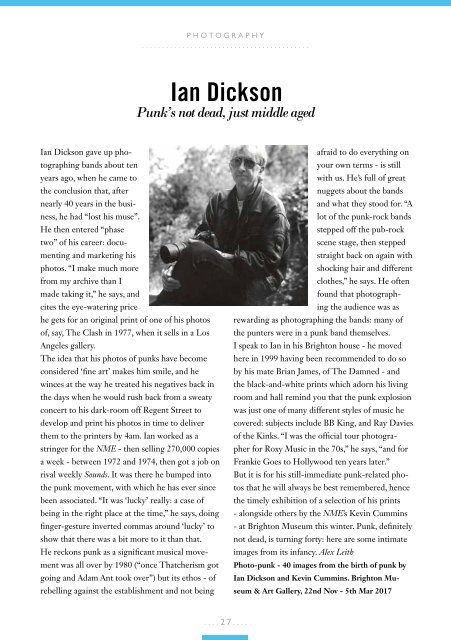Viva Brighton Issue #45 November 2016
You also want an ePaper? Increase the reach of your titles
YUMPU automatically turns print PDFs into web optimized ePapers that Google loves.
PHOTOGRAPHY<br />
..........................................<br />
Ian Dickson<br />
Punk’s not dead, just middle aged<br />
Ian Dickson gave up photographing<br />
bands about ten<br />
years ago, when he came to<br />
the conclusion that, after<br />
nearly 40 years in the business,<br />
he had “lost his muse”.<br />
He then entered “phase<br />
two” of his career: documenting<br />
and marketing his<br />
photos. “I make much more<br />
from my archive than I<br />
made taking it,” he says, and<br />
cites the eye-watering price<br />
he gets for an original print of one of his photos<br />
of, say, The Clash in 1977, when it sells in a Los<br />
Angeles gallery.<br />
The idea that his photos of punks have become<br />
considered ‘fine art’ makes him smile, and he<br />
winces at the way he treated his negatives back in<br />
the days when he would rush back from a sweaty<br />
concert to his dark-room off Regent Street to<br />
develop and print his photos in time to deliver<br />
them to the printers by 4am. Ian worked as a<br />
stringer for the NME - then selling 270,000 copies<br />
a week - between 1972 and 1974, then got a job on<br />
rival weekly Sounds. It was there he bumped into<br />
the punk movement, with which he has ever since<br />
been associated. “It was ‘lucky’ really: a case of<br />
being in the right place at the time,” he says, doing<br />
finger-gesture inverted commas around ‘lucky’ to<br />
show that there was a bit more to it than that.<br />
He reckons punk as a significant musical movement<br />
was all over by 1980 (“once Thatcherism got<br />
going and Adam Ant took over”) but its ethos - of<br />
rebelling against the establishment and not being<br />
afraid to do everything on<br />
your own terms - is still<br />
with us. He’s full of great<br />
nuggets about the bands<br />
and what they stood for. “A<br />
lot of the punk-rock bands<br />
stepped off the pub-rock<br />
scene stage, then stepped<br />
straight back on again with<br />
shocking hair and different<br />
clothes,” he says. He often<br />
found that photographing<br />
the audience was as<br />
rewarding as photographing the bands: many of<br />
the punters were in a punk band themselves.<br />
I speak to Ian in his <strong>Brighton</strong> house - he moved<br />
here in 1999 having been recommended to do so<br />
by his mate Brian James, of The Damned - and<br />
the black-and-white prints which adorn his living<br />
room and hall remind you that the punk explosion<br />
was just one of many different styles of music he<br />
covered: subjects include BB King, and Ray Davies<br />
of the Kinks. “I was the official tour photographer<br />
for Roxy Music in the 70s,” he says, “and for<br />
Frankie Goes to Hollywood ten years later.”<br />
But it is for his still-immediate punk-related photos<br />
that he will always be best remembered, hence<br />
the timely exhibition of a selection of his prints<br />
- alongside others by the NME’s Kevin Cummins<br />
- at <strong>Brighton</strong> Museum this winter. Punk, definitely<br />
not dead, is turning forty: here are some intimate<br />
images from its infancy. Alex Leith<br />
Photo-punk - 40 images from the birth of punk by<br />
Ian Dickson and Kevin Cummins. <strong>Brighton</strong> Museum<br />
& Art Gallery, 22nd Nov - 5th Mar 2017<br />
....27....


















